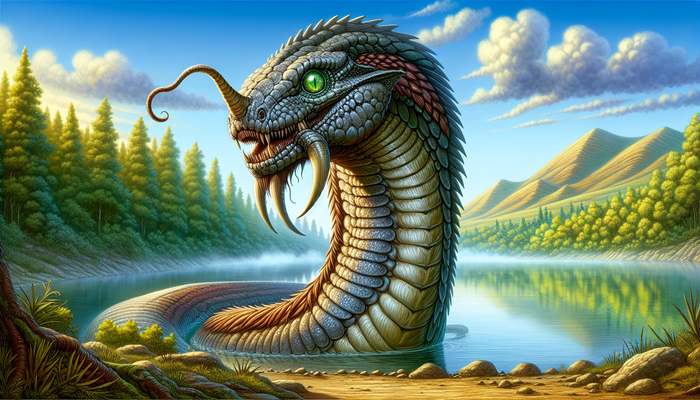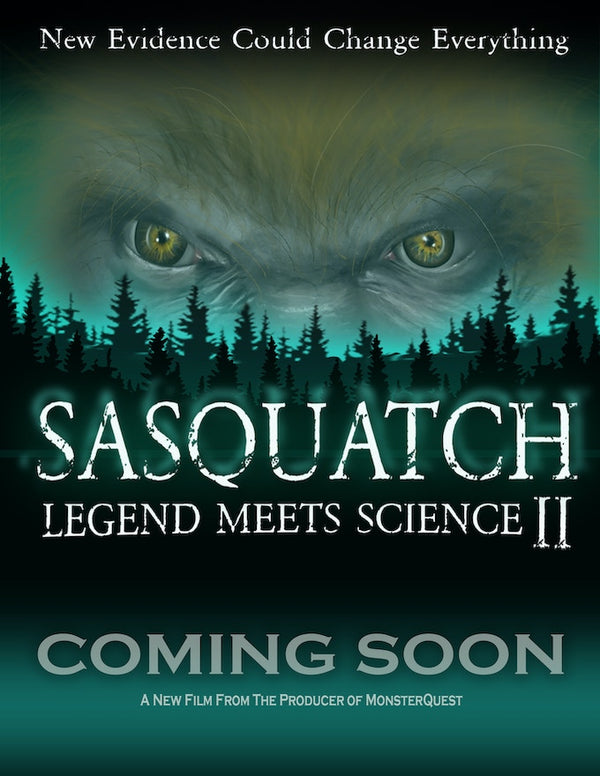Exploring Cryptid Habitats and Ecosystems: Where Legends Lurk

By Anthony Romano, Cryptozoologist
In the shadowy corners of our world, where science meets folklore, there exists a realm of creatures that captivate our imagination and challenge our understanding of nature. These elusive beings, known as cryptids, have long been the subject of fascination for both researchers and enthusiasts alike. From the dense forests of the Pacific Northwest to the murky depths of Scottish lochs, cryptids are said to inhabit a diverse array of ecosystems, each as mysterious as the creatures themselves.
But what exactly are cryptids, and why do they continue to intrigue us? Cryptids are animals or creatures whose existence is suggested through anecdotal evidence, folklore, or unverified sightings, yet remain unproven by scientific standards. The study of these enigmatic beings falls under the umbrella of cryptozoology, a field that blends elements of biology, anthropology, and folklore. While often dismissed as pseudoscience by mainstream academia, cryptozoology has garnered a dedicated following of enthusiasts and researchers who seek to uncover the truth behind these legendary creatures.
The allure of cryptids lies not just in their potential existence, but in the stories they inspire and the ecosystems they allegedly inhabit. These creatures serve as a reminder that our world still holds mysteries, even in an age of advanced technology and scientific understanding. By exploring the habitats and ecosystems associated with cryptids, we gain insight into the complex relationships between folklore, conservation, and the human desire for discovery.
In this exploration, we'll venture into the various habitats where cryptids are said to dwell, examining the ecological roles they might play and the cultural significance they hold. From the towering forests that may hide Bigfoot to the remote mountain ranges where the Yeti is said to roam, we'll uncover the fascinating interplay between these legendary creatures and their environments.
The Forests and Woodlands: Home to the Elusive Bigfoot
When we think of cryptids, few capture the imagination quite like Bigfoot, also known as Sasquatch. This legendary creature is said to inhabit the vast, primeval forests of the Pacific Northwest, a region known for its towering trees, dense undergrowth, and misty landscapes. The ecosystem of these forests provides the perfect backdrop for a large, elusive primate to remain hidden from human eyes.
The Pacific Northwest's temperate rainforests are characterized by their diverse flora and fauna. Towering Douglas firs, western red cedars, and Sitka spruces create a canopy that filters sunlight, casting the forest floor in perpetual twilight. This environment is rich in biodiversity, supporting a variety of wildlife that could, theoretically, sustain a large omnivorous creature like Bigfoot.
Eyewitness accounts often describe Bigfoot as a massive, bipedal creature standing between 7 to 10 feet tall, covered in dark, shaggy hair. These reports suggest that Bigfoot possesses both strength and agility, allowing it to navigate the rugged terrain with ease. The creature's reported diet is diverse, potentially including berries, roots, fish, and small mammals – all of which are abundant in the Pacific Northwest ecosystem.
The dense vegetation and limited visibility in these forests could explain why concrete evidence of Bigfoot remains elusive. The forest floor, covered in moss and decaying plant matter, may not preserve footprints well, while the thick canopy could obscure aerial searches. Additionally, the region's frequent rainfall could wash away potential DNA evidence before it can be collected.
Interestingly, the concept of Bigfoot is not unique to North America. Similar creatures are reported in other forested regions around the world, such as the Yeren in China and the Yowie in Australia. This global distribution of forest-dwelling cryptids suggests a universal human fascination with the idea of undiscovered primates lurking in the wilderness.
The potential existence of Bigfoot raises intriguing questions about forest ecology. If such a creature did exist, it would likely play a significant role in its ecosystem. As a large omnivore, Bigfoot could influence plant distribution through seed dispersal and impact prey populations. Its presence might also affect the behavior of other forest animals, similar to how the reintroduction of wolves in Yellowstone National Park led to a cascade of ecological changes.
However, the lack of conclusive evidence for Bigfoot's existence has led many scientists to dismiss the creature as a myth or a case of misidentification. Critics argue that the Pacific Northwest's ecosystem, while vast, is unlikely to support a breeding population of large, unknown primates without leaving more tangible traces of their presence.
Despite the skepticism, the legend of Bigfoot continues to thrive, inspiring countless expeditions, research projects, and conservation efforts. The search for this elusive creature has inadvertently contributed to a greater appreciation for the biodiversity and ecological importance of the Pacific Northwest's forests. Whether Bigfoot exists or not, its legend serves as a powerful reminder of the mysteries that still lurk in our world's wild places.
Mountains and High Altitudes: The Domain of the Yeti
As we ascend from the misty forests of the Pacific Northwest to the snow-capped peaks of the Himalayas, we encounter another legendary cryptid: the Yeti, often referred to as the Abominable Snowman. This mythical creature is said to inhabit the remote and treacherous mountain ranges of Central Asia, particularly the Himalayan region spanning Nepal, Tibet, and Bhutan.
The Yeti's purported habitat is one of the most extreme environments on Earth. The Himalayan ecosystem is characterized by its harsh climate, thin air, and rugged terrain. At high altitudes, vegetation is sparse, and wildlife is specially adapted to survive in these challenging conditions. This unforgiving landscape has fueled the imagination of explorers and locals alike, giving rise to tales of a mysterious, ape-like creature that roams the snowy peaks.
Descriptions of the Yeti vary, but it is often portrayed as a large, bipedal creature covered in thick, white or reddish-brown fur. Some accounts describe it as more human-like, while others liken it to a giant ape. The creature is said to be well-adapted to its high-altitude home, possessing strength and agility that allow it to traverse steep, icy slopes with ease.
The ecological niche of the Yeti, if it exists, would be fascinating to consider. In an environment where resources are scarce, such a large creature would need to be an opportunistic omnivore. Its diet might include mountain goats, plants, and perhaps even scavenged material from lower altitudes. The Yeti's presence could potentially influence the behavior and distribution of other high-altitude species, such as snow leopards and Himalayan tahrs.
The cultural significance of the Yeti in the Himalayan region cannot be overstated. Many local communities view the creature not just as a physical entity, but as a spiritual being intrinsically linked to the mountains. In Sherpa folklore, the Yeti is often portrayed as a guardian of the mountains, embodying the raw power and mystery of the high-altitude wilderness. This spiritual dimension adds another layer of complexity to the Yeti legend, blending natural history with cultural beliefs.
Scientific expeditions in search of the Yeti have yielded intriguing, albeit inconclusive, results. Footprints found in snow and ice have been attributed to the creature, though skeptics argue these could be the tracks of known animals distorted by melting and refreezing. Hair samples collected from high-altitude areas have been analyzed, with some studies suggesting they belong to an unknown primate species. However, more recent DNA analysis has linked these samples to bears native to the region.
The search for the Yeti has had unintended positive consequences for conservation efforts in the Himalayas. Expeditions have led to the discovery of new species and have drawn attention to the unique and fragile ecosystem of the high mountains. The legend of the Yeti has become a powerful symbol for conservation, highlighting the need to protect these remote areas and the biodiversity they support.
Critics argue that the harsh conditions and limited resources of the Himalayan ecosystem make it unlikely to support a large, unknown primate species. They suggest that Yeti sightings may be misidentifications of known animals, such as bears or large monkeys, viewed under challenging conditions. The psychological impact of high-altitude environments on human perception is also cited as a potential factor in Yeti sightings.
Despite the lack of conclusive evidence, the Yeti remains an integral part of Himalayan culture and continues to capture the imagination of people worldwide. The creature represents the enduring mystery of the mountains and serves as a reminder of how much we still have to learn about the most remote corners of our planet.
Aquatic Environments: Monsters of the Deep
From the icy peaks of the Himalayas, we descend into the murky depths of lakes and oceans, where some of the most enduring cryptid legends have taken root. Aquatic cryptids have captured human imagination for centuries, with tales of mysterious creatures lurking beneath the waves spanning cultures and continents. Among these aquatic enigmas, two stand out for their enduring popularity and the fervor they inspire: the Loch Ness Monster of Scotland and Champ of Lake Champlain.
The Loch Ness Monster, affectionately known as Nessie, is perhaps the most famous aquatic cryptid in the world. Loch Ness, the largest freshwater body in Great Britain by volume, provides an ideal setting for such a legend. The loch is deep, cold, and often shrouded in mist, creating an atmosphere of mystery that has fueled speculation for generations.
Descriptions of Nessie typically depict a large, long-necked creature with a small head, reminiscent of a plesiosaur – a marine reptile that went extinct millions of years ago. The idea that a prehistoric creature could have survived in the loch for millennia is part of what makes the Loch Ness Monster so captivating.
The ecosystem of Loch Ness is complex and not fully understood. The loch's great depth (reaching over 750 feet in places) and its connection to the sea via the River Ness have led some to speculate that it could support large, unknown species. The loch is home to a variety of fish, including Atlantic salmon and sea trout, which could theoretically provide a food source for a large predator.
However, skeptics argue that the loch's ecosystem is not productive enough to support a breeding population of large, unknown animals. They point out that the food chain in Loch Ness is relatively simple, and the introduction of a large predator would have noticeable effects on fish populations – effects that have not been observed.
Across the Atlantic, Lake Champlain boasts its own aquatic mystery in the form of Champ. Like Nessie, Champ is often described as a long-necked, serpentine creature. The lake, which straddles the border between New York and Vermont, shares some characteristics with Loch Ness – it's deep, cold, and has a complex underwater topography.
Lake Champlain's ecosystem is more diverse than that of Loch Ness, supporting a wider variety of fish species and other aquatic life. This richer environment has led some cryptozoologists to suggest that it could more plausibly support an unknown large species. Sightings of Champ date back to indigenous legends and continue to the present day, with some eyewitnesses claiming to have seen multiple creatures at once, suggesting a breeding population.
The search for these aquatic cryptids has led to some fascinating scientific endeavors. Sonar surveys of both Loch Ness and Lake Champlain have revealed intriguing anomalies, though none have conclusively proven the existence of large unknown creatures. These studies have, however, contributed to our understanding of lake ecosystems and underwater geology.
Environmental DNA (eDNA) analysis has also been employed in the search for aquatic cryptids. This technique allows researchers to detect genetic material shed by organisms into their environment. While eDNA studies in Loch Ness have not found evidence of unknown large animals, they have revealed a surprising diversity of life, including species not previously known to inhabit the loch.
The legends of Nessie and Champ have had significant impacts on their local communities. Both have become cultural icons, driving tourism and inspiring conservation efforts. The search for these creatures has led to increased scientific interest in their respective ecosystems, contributing to our understanding of freshwater ecology and the need for aquatic conservation.
Critics argue that the persistence of these legends in the face of extensive scientific investigation demonstrates the power of human imagination and our desire for mystery. They suggest that most sightings can be explained by misidentifications of known animals, optical illusions caused by wave patterns, or in some cases, deliberate hoaxes.
Whether real or imaginary, aquatic cryptids like Nessie and Champ serve as powerful symbols of the unknown depths that still exist in our world. They remind us that even in well-studied ecosystems, there is always the potential for discovery and wonder.
Rural and Suburban Cryptids: Legends Close to Home
While many cryptids are associated with remote wilderness areas, some of the most intriguing legends emerge from the fringes of human habitation. Rural and suburban cryptids occupy a unique space in cryptozoology, blending elements of folklore with modern-day mystery. These creatures are often said to inhabit the liminal spaces between wild and settled areas, leading to more frequent alleged encounters with humans. One of the most notorious of these cryptids is the chupacabra, a creature that has terrorized rural communities across the Americas.
The chupacabra, whose name translates to "goat-sucker" in Spanish, first gained widespread attention in Puerto Rico in the mid-1990s. Since then, reports of the creature have spread throughout Latin America and the southern United States. Unlike many cryptids associated with specific locales, the chupacabra seems to have a wide-ranging habitat, adapting to various rural and semi-rural environments.
Descriptions of the chupacabra vary widely, but it is often portrayed as a reptilian or canine creature with leathery or scaly greenish-gray skin, sharp claws, and rows of spines running down its back. Some accounts describe it as bipedal, while others depict it as a quadruped. The most consistent feature in chupacabra reports is its alleged habit of attacking livestock and draining them of blood through small, circular incisions.
The ecosystem that the chupacabra is said to inhabit is a blend of agricultural land, scrubland, and forest edges. This diverse environment provides ample cover for a predatory creature and a steady supply of potential prey in the form of livestock. The chupacabra's reported behavior suggests it would occupy a niche similar to that of other medium-sized predators, potentially competing with coyotes, foxes, and feral dogs.
From an ecological perspective, the existence of the chupacabra would raise intriguing questions about predator-prey dynamics in rural areas. If real, such a creature could have significant impacts on livestock populations and potentially alter the behavior of other wild animals in the area. However, skeptics argue that chupacabra sightings are likely misidentifications of known animals, particularly canines with mange or other skin conditions that give them an unusual appearance.
The chupacabra legend has had tangible effects on rural communities. In some areas, farmers have altered their livestock management practices in response to fears of chupacabra attacks. This has led to increased use of enclosed shelters and night-time monitoring of animals, which can have both positive and negative impacts on animal welfare and farm productivity.
Interestingly, the chupacabra myth has evolved alongside changes in rural landscapes. As human settlements expand into previously wild areas, encounters with unfamiliar wildlife become more common. The chupacabra legend may reflect anxieties about these changing relationships between humans and nature, as well as economic concerns in agricultural communities.
The cultural impact of the chupacabra extends beyond rural areas. The creature has become a pop culture icon, featured in movies, television shows, and urban legends. This widespread recognition has led to increased interest in Latin American folklore and has sparked discussions about the intersection of traditional beliefs and modern cryptozoology.
Scientific investigations into chupacabra reports have yielded some interesting findings. DNA analysis of animals suspected to be chupacabras has consistently identified them as known species, often canines with severe mange or other conditions. These studies highlight the importance of scientific inquiry in understanding and contextualizing cryptid sightings.
The persistence of the chupacabra legend, despite lack of concrete evidence, speaks to the power of folklore in shaping our perceptions of the natural world. It also underscores the complex relationships between humans and wildlife in rural and suburban areas. As these environments continue to change and evolve, it's likely that new cryptid legends will emerge, reflecting our ongoing fascination with the unknown creatures that may lurk just beyond our backyards.
Urban Cryptids: Mysteries in the Concrete Jungle
While many cryptids are associated with wild, remote locations, some of the most intriguing legends emerge from the heart of our cities and towns. Urban cryptids challenge our perception of the modern world, suggesting that even in the most developed areas, mysteries can still thrive. These creatures are often intertwined with local history and urban legends, reflecting the unique character of their supposed habitats. One of the most famous urban cryptids is the Mothman, a winged humanoid creature said to haunt the town of Point Pleasant, West Virginia.
The Mothman first entered public consciousness in November 1966, when two couples driving near an abandoned TNT plant outside Point Pleasant reported seeing a large, gray creature with glowing red eyes and a wingspan of 10 feet. Over the next year, dozens of similar sightings were reported, creating a wave of fear and fascination that gripped the small town.
Descriptions of the Mothman typically portray it as a tall, winged being with a human-like body and large, reflective eyes. Some accounts describe it as having a bird-like head, while others claim it has no discernible head at all. The creature is said to be capable of flight, often described as taking off vertically like a helicopter.
The urban ecosystem that the Mothman allegedly inhabits is quite different from the wilderness domains of other cryptids. Point Pleasant, a small city along the Ohio River, provides a mix of industrial areas, residential neighborhoods, and nearby woodlands. This diverse environment offers potential hiding spots and hunting grounds for an adaptable creature.
From an ecological perspective, the existence of a large, flying predator in an urban area would have significant implications. Such a creature would need to navigate human structures, avoid detection, and find sufficient food sources in a relatively limited area. Some cryptozoologists have speculated that the Mothman could be a previously unknown species of giant owl or bat, adapted to urban environments.
The Mothman legend is inextricably linked to the tragic collapse of the Silver Bridge in December 1967, which killed 46 people. Many believers view the Mothman sightings as premonitions or warnings of the impending disaster. This connection has elevated the Mothman from a mere cryptid to a prophetic figure in local folklore.
The impact of the Mothman legend on Point Pleasant has been profound. The creature has become a cultural icon for the town, inspiring an annual Mothman Festival that draws thousands of visitors. A large metallic statue of the Mothman stands in the town center, and the Mothman Museum showcases memorabilia and eyewitness accounts. This embrace of the legend has had significant economic benefits for the community, demonstrating how urban cryptids can become integral to a city's identity and tourism industry.
Scientific explanations for Mothman sightings have ranged from misidentifications of known animals, such as large birds or escaped exotic pets, to mass hysteria fueled by Cold War tensions and industrial pollution fears. Some researchers have pointed to the sandhill crane, a large bird with reddish patches around its eyes, as a possible source for some Mothman sightings.
The persistence of the Mothman legend in an urban setting raises interesting questions about how we perceive our built environments. Cities are often seen as known, mapped, and controlled spaces, leaving little room for mystery. The idea of an unknown creature inhabiting these familiar areas challenges this perception, suggesting that even in the heart of human civilization, there may be aspects of the natural world that elude our understanding.
Urban cryptids like the Mothman also reflect the unique anxieties and preoccupations of city dwellers. In an environment dominated by human activity, these creatures represent a intrusion of the wild and unpredictable into ordered urban life. They may embody fears about the consequences of urbanization, industrial development, or the loss of connection with nature.
The study of urban cryptids intersects with other fields such as urban ecology and wildlife biology. As cities expand and green spaces within urban areas become more valued, there's growing interest in how wildlife adapts to urban environments. While the Mothman remains firmly in the realm of legend, the idea of unexpected creatures in cities is not entirely far-fetched. Recent years have seen increasing reports of wild animals, from coyotes to mountain lions, venturing into urban areas.
The Mothman and other urban cryptids serve as powerful reminders that mystery and wonder can exist even in the most familiar settings. They challenge us to look at our cities with fresh eyes, considering the possibility that the unknown may be lurking just around the corner. Whether real or imaginary, these urban legends contribute to the rich tapestry of stories that make our cities unique and captivating.
The Interconnectedness of Cryptids and Their Ecosystems
As we've explored the various habitats associated with cryptids, from dense forests to urban landscapes, a common thread emerges: the intricate relationship between these legendary creatures and their environments. This interconnectedness raises fascinating questions about ecology, conservation, and our understanding of natural systems. Even if cryptids remain unproven, the study of their supposed habitats and behaviors can offer valuable insights into real-world ecosystems and our relationship with the natural world.
One of the most intriguing aspects of cryptid ecology is the potential role these creatures might play in their ecosystems if they did exist. Many cryptids are described as large, predatory animals, which would place them at or near the top of their local food chains. The presence of such apex predators can have far-reaching effects on an ecosystem, influencing the behavior and populations of other species.
For example, if Bigfoot were real, its presence in Pacific Northwest forests could impact prey species populations, affect the distribution of plant life through foraging and seed dispersal, and even influence the behavior of other large predators like bears and mountain lions. Similarly, the existence of a large, unknown aquatic predator like the Loch Ness Monster would have significant implications for fish populations and the overall ecological balance of the loch.
These theoretical ecological roles highlight the concept of trophic cascades, where changes at one level of the food chain can have ripple effects throughout the entire ecosystem. While cryptids remain unproven, considering their potential ecological impacts encourages us to think more deeply about the complex interactions within natural systems.
The search for cryptids has also had tangible effects on conservation efforts. Many cryptid habitats are in remote or ecologically sensitive areas, and the interest generated by these legendary creatures has drawn attention to the need for habitat preservation. For instance, the popularity of Bigfoot has led to increased public interest in the conservation of old-growth forests in the Pacific Northwest. Similarly, efforts to protect Loch Ness and its surroundings have been bolstered by the enduring mystery of the Loch Ness Monster.
This connection between cryptozoology and conservation is not without controversy. Some conservationists argue that focusing on unproven creatures distracts from the very real threats facing known species. However, others see cryptid-inspired conservation as a way to engage the public and generate support for habitat protection that benefits all species, known and unknown.
Climate change adds another layer of complexity to the study of cryptid habitats. As ecosystems shift in response to changing temperatures and weather patterns, the theoretical ranges of cryptids would also be affected. This consideration has led some cryptozoologists to speculate about how creatures like the Yeti might adapt to warming mountain environments or how aquatic cryptids might respond to changes in water temperature and chemistry.
While these speculations remain firmly in the realm of theory, they mirror very real concerns about how climate change is impacting known species and ecosystems. The idea of cryptids adapting to changing environments can serve as an engaging way to discuss broader issues of climate change and biodiversity loss with the public.
The study of cryptid habitats also intersects with the field of habitat restoration. In some cases, efforts to recreate the type of pristine environments where cryptids are said to dwell can have positive impacts on biodiversity and ecosystem health. For example, projects to restore wetland habitats in search of creatures like the Loveland Frog can benefit a wide range of amphibian species and improve water quality.
The concept of "rewilding" – reintroducing species to areas where they have become extinct – has some parallels with cryptozoology. Both involve the idea of restoring ecosystems to a more "natural" state, whether by reintroducing known species or by imagining the presence of unknown ones. This connection highlights how the study of cryptids can contribute to broader discussions about ecosystem management and the role of wildlife in modern landscapes.
Cryptids also serve as powerful symbols of the unknown in nature, reminding us that our understanding of the natural world is far from complete. This aspect of cryptozoology aligns with the scientific principle that our knowledge is always evolving, and that we should remain open to new discoveries. While the existence of creatures like Bigfoot or the Loch Ness Monster remains highly improbable, the history of zoology includes examples of species once thought mythical, such as the giant squid, later being confirmed.
The interconnectedness of cryptids and their ecosystems extends beyond the physical environment to include cultural and psychological dimensions. Many cryptid legends are deeply rooted in local cultures, reflecting traditional knowledge about the land and its inhabitants. These stories often encode information about the behavior of real animals, weather patterns, and other natural phenomena, serving as a form of ecological knowledge passed down through generations.
In conclusion, while cryptids themselves may be the stuff of legend, the study of their supposed habitats and ecological roles offers valuable perspectives on real-world ecosystems. By considering how these creatures might interact with their environments, we gain a deeper appreciation for the complexity of natural systems and the importance of conservation. The enduring fascination with cryptids also serves as a reminder of the wonder and mystery that still exists in the natural world, encouraging us to look at familiar environments with fresh eyes and an open mind.
Cultural Significance of Cryptids and Their Ecosystems
The allure of cryptids extends far beyond the realm of biology and ecology, deeply permeating human culture and psychology. These elusive creatures have become powerful symbols in folklore, literature, and popular media, reflecting our complex relationship with the natural world and the unknown. The cultural significance of cryptids and their supposed habitats offers fascinating insights into how we perceive and interact with our environment.
Cryptids often serve as embodiments of local identity and cultural heritage. Many communities have embraced their local cryptid legends, incorporating them into regional lore and traditions. For example, the town of Point Pleasant, West Virginia, has fully embraced the Mothman legend, hosting an annual Mothman Festival that draws thousands of visitors. This event not only boosts the local economy but also strengthens community bonds and preserves local history.
Similarly, the Loch Ness Monster has become an integral part of Scottish culture, particularly in the Highlands. "Nessie" appears on everything from tourist souvenirs to official regional logos, serving as a mascot for the area. The creature has become so entwined with local identity that efforts to "debunk" the Loch Ness Monster are often met with resistance, not just from true believers, but from those who appreciate the legend's cultural value.
These cryptid-centric celebrations highlight how legendary creatures can become focal points for cultural expression and community pride. They provide a shared narrative that connects people to their local environment and history, fostering a sense of place and belonging.
The influence of cryptids on popular culture cannot be overstated. These creatures have inspired countless books, movies, television shows, and video games. From classic novels like Arthur Conan Doyle's "The Lost World" to modern films like "The Shape of Water," cryptids have captivated audiences for generations. This media representation often reflects broader cultural anxieties and fascinations, with cryptids serving as metaphors for the unknown, the primitive, or the misunderstood.
In many indigenous cultures, creatures that might be classified as cryptids by Western standards are integral parts of traditional belief systems and ecological knowledge. For instance, the Yeti of the Himalayas is not just a mysterious animal to many Sherpa people, but a spiritual being connected to the mountains. These beliefs often encode important information about local ecosystems and sustainable practices, highlighting the deep connections between cultural traditions and environmental stewardship.
The study of cryptids and their habitats can also serve as a gateway to broader environmental awareness. Many people who become interested in creatures like Bigfoot or the Loch Ness Monster find themselves developing a deeper appreciation for the ecosystems these creatures supposedly inhabit. This can lead to increased support for conservation efforts and a greater understanding of ecological issues.
Cryptid tourism has become a significant economic factor in many regions. Areas associated with famous cryptids often see boosts in visitor numbers, leading to the development of museums, tours, and other attractions. While this can bring much-needed revenue to rural or economically depressed areas, it also raises questions about the commodification of nature and the potential impact of tourism on fragile ecosystems.
The psychological appeal of cryptids offers insights into human nature and our relationship with the unknown. The persistence of cryptid beliefs in the face of scientific skepticism demonstrates our desire for mystery and our reluctance to accept that the world has been fully explored and explained. Cryptids represent the possibility of discovery, the thrill of the unknown, and perhaps a longing for a world less constrained by scientific rationalism.
Some psychologists and anthropologists suggest that cryptid legends may serve adaptive functions in human societies. These stories might help to reinforce boundaries (don't go into the deep woods alone), transmit environmental knowledge (beware of dangerous areas in lakes or rivers), or provide explanations for unusual events or observations.
The intersection of cryptozoology with mainstream science has led to interesting debates about the nature of evidence, the role of eyewitness testimony, and the boundaries of scientific inquiry. While most scientists dismiss the existence of famous cryptids, the methods and passion of amateur cryptozoologists have occasionally contributed to biological discoveries. For example, the study of "sea serpent" sightings has contributed to our understanding of the behavior of known marine animals like oarfish.
Cryptids also play a role in environmental education and outreach. The mystery and excitement surrounding these creatures can be used as a hook to engage people, especially children, in learning about real animals, habitats, and conservation issues. Many wildlife organizations and museums have found that framing educational content around the search for mysterious animals can be an effective way to spark interest in broader ecological topics.
The cultural significance of cryptids extends to the realm of art and creativity. These creatures have inspired countless works of art, from traditional sculptures and paintings to modern digital art and augmented reality experiences. Cryptid-themed art often blends elements of the natural world with the fantastical, challenging viewers to reconsider their perceptions of reality and nature.
In the digital age, cryptids have found new life in online communities and social media. Websites, forums, and social media groups dedicated to cryptozoology allow enthusiasts from around the world to share experiences, debate evidence, and collaborate on investigations. This online presence has democratized the study of cryptids, allowing amateur researchers to contribute to the field and share their findings with a global audience.
The enduring fascination with cryptids in various cultures around the world speaks to a universal human desire for wonder and exploration. Even as our scientific understanding of the world grows, these legends remind us of the joy of mystery and the excitement of the hunt. They encourage us to look at our environments with fresh eyes, always open to the possibility of discovery.
In conclusion, the cultural significance of cryptids and their ecosystems is multi-faceted and profound. These creatures serve as powerful symbols of the unknown, catalysts for community identity, subjects of artistic expression, and gateways to environmental awareness. Whether real or imaginary, cryptids continue to shape our cultural landscape, influencing how we perceive and interact with the natural world around us.
The Future of Cryptid Research and Conservation
As we look to the future, the field of cryptozoology and its relationship with mainstream science and conservation efforts continues to evolve. Advancements in technology, changing attitudes towards interdisciplinary research, and growing environmental concerns are shaping new approaches to the study of cryptids and their habitats. While the existence of legendary creatures like Bigfoot or the Loch Ness Monster remains unproven, the pursuit of these mysteries is driving innovation in research methods and fostering a renewed appreciation for the complexity of our natural world.
One of the most significant developments in cryptid research is the application of cutting-edge technology. Environmental DNA (eDNA) analysis, for example, allows researchers to detect genetic material shed by organisms into their environment. This technique has been used in high-profile investigations, such as the 2019 study of Loch Ness. While this particular study did not find evidence of a large unknown animal, it did reveal a diverse ecosystem and demonstrated the potential of eDNA analysis in understanding aquatic environments.
Advances in camera technology, including high-resolution trail cameras and drones equipped with thermal imaging, are providing new ways to survey remote areas where cryptids are said to dwell. These tools allow for non-invasive monitoring of wildlife and have the potential to capture evidence of unknown species, if they exist. Even when cryptids aren't found, these surveys often yield valuable data on known species and ecosystem health.
Artificial intelligence and machine learning are also playing an increasing role in cryptid research.
From Bigfoot to UFOs: Hangar 1 Publishing Has You Covered!
Explore Untold Stories: Venture into the world of UFOs, cryptids, Bigfoot, and beyond. Every story is a journey into the extraordinary.
Immersive Book Technology: Experience real videos, sights, and sounds within our books. Its not just reading; its an adventure.



























